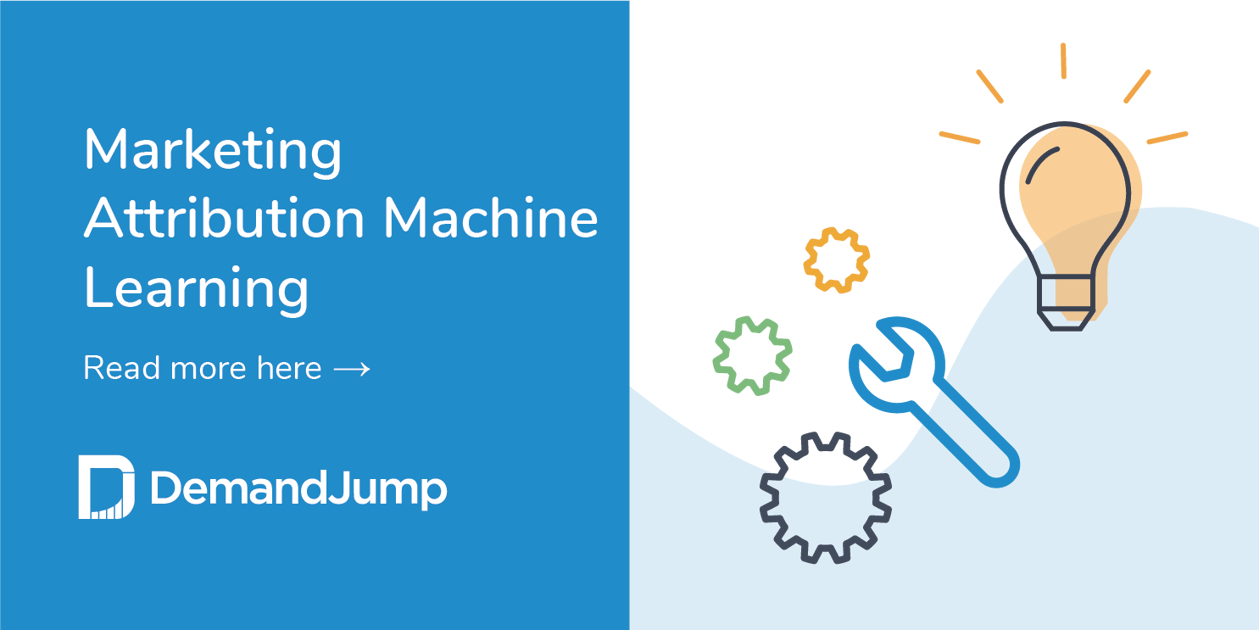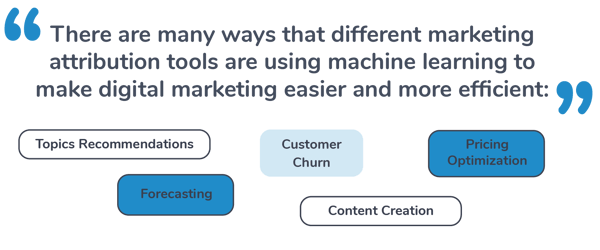Marketing Attribution With Machine Learning
December 8, 2020 •DJ Team

Machine learning is a term you’ve certainly heard, but could you answer a trivia question about it? Most people would not be able to define machine learning, even as it transforms the world around us. So let’s fix that right now!
Simply put, you can think of machine learning as a computer being instructed to recognize patterns in data. When a user submits months or years of data to the scrutiny of machine learning, what they receive back is actionable insights based on findings in the data. So if you sent all your bank statements to a machine learning tool, you could find out in return what days of the week you’re most likely to shop online, and how much you will spend shopping online in the next month. Though you may already suspect some of those findings, they would be confirmed (or disproven) by the machine’s analysis.
In the marketing industry especially, machine learning has the potential to generate huge savings in time and money. When professionals can attribute success to specific pieces of content and content channels, they can focus energy and spending on those top performers.
There are several specific ways marketing attribution with machine learning helps provide more accurate and usable insights. Here’s the research on the subject, as well as marketing attribution tools that can put this innovation to work for you today—no change in personal shopping habits required.
What is a Data-Driven Attribution Model?
Data-driven marketing attribution is the latest type of digital marketing attribution that has become available. Unlike more established forms of digital marketing attribution, data-driven attribution models calculate the actual impact of each ad along the customer journey to a buying decision. Even the most advanced multi-touch attribution models still function by determining that each piece of content the user interacts with will receive a percentage of the credit, even when it didn’t actually inform the buying decision. Data-driven attribution uses metrics like the ad format, the time between viewing ads, what type of device the customer was using, and other data to take the analysis even further.
Data-driven attribution models in Google Analytics also compare the user journeys of customers who converted to customers who didn’t. Then, the technology can estimate the probability of conversion in your future ad campaigns through what is called a “survivability analysis.”
This is an incredible benefit! However, there is a base amount of data required to start using data-driven attribution, and a specific amount of data must be sent each month for the program to be sustained. To start through Google, you must have at least 3,000 ad interactions and 300 conversions in 30 days. After that initial benchmark, if you drop below 2,000 interactions and 200 conversions in 30 days, the model will default to a more traditional marketing attribution model.
How a Machine Learning Attribution Model Is Unique
Data-driven attribution modeling is not the only way for predictive machine learning to support your marketing strategy. The main distinction is that machine learning marketing attribution is based on your unique historic data, versus arbitrary rules like last-click or first-click. While traditional rules-based marketing attribution models are easier to implement and prove useful in many circumstances, they don’t provide the most insight possible.
There are many ways that different marketing attribution tools are using machine learning to make digital marketing easier and more efficient:
- Topics Recommendations: Through attribution insights, machine learning systems can make recommendations about future topics audiences will find interesting.
- Forecasting: An analysis of past conversions will help with accurate pipeline forecasting for the future.
- Customer Churn: Machine learning can identify customers likely to leave and present the opportunity to retain them.
- Content Creation: Beyond recommending topics, machine learning attribution models can help marketers create content on the right channels.
- Pricing Optimization: The most powerful machine learning can give companies the real-time insights needed to carry out dynamic pricing in line with search trends.

Machine learning marketing attribution gives powerful insights into what is working for your marketing team today, and helps you get ahead of the trends and customer journeys coming tomorrow.
Get a Marketing Attribution Tool Providing Actionable Insights from Machine Learning
The purpose of marketing attribution is to find out which of your marketing efforts are making the biggest impact on your conversions. When your marketing attribution tool is paired with machine learning, this means you go from looking back at the past to looking forward at the future. We created the DemandJump platform to take marketers and owners from a reactionary position into a position of action.
Insights help you gain perspective on where gaps left by your competitors are yours to act on. Analytics and attribution help you understand the unique journey of your customers and close the loop between sales and marketing. And all this is underscored with data-driven recommendations about the advertising and marketing actions to take next. Try it all risk-free with a free trial and learn what the future holds for your success.
Featured Articles
Categories
- Attribution Tracking (13)
- Channel Optimization (11)
- Consumer Insights (68)
- Content Marketing (251)
- Data Science (8)
- Digital Marketing (6)
- Digital Transformation (26)
- Enterprise (10)
- Lead Generation (14)
- Market Intelligence (8)
- Marketing Analytics (39)
- Marketing Attribution (57)
- Marketing Management (153)
- Marketing Operations (86)
- Organic Search (222)
- Paid Search (52)
- Pillar-Based Marketing (63)
- Programmatic Advertising (9)
- SaaS Content (14)
- SaaS Marketing (29)
- Search Marketing (111)
- SEO Keyword Research (28)
- SEO Pillar (18)
- SEO Strategy (46)
- SMB (5)
- Website Content (12)

